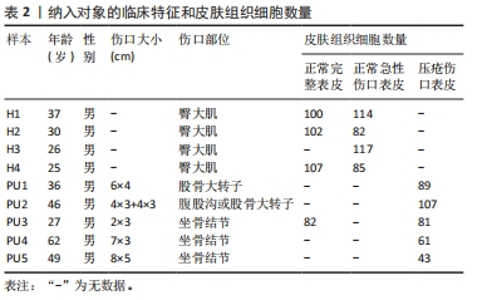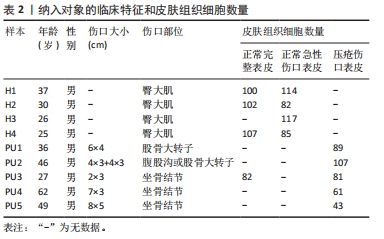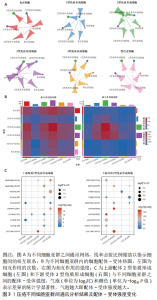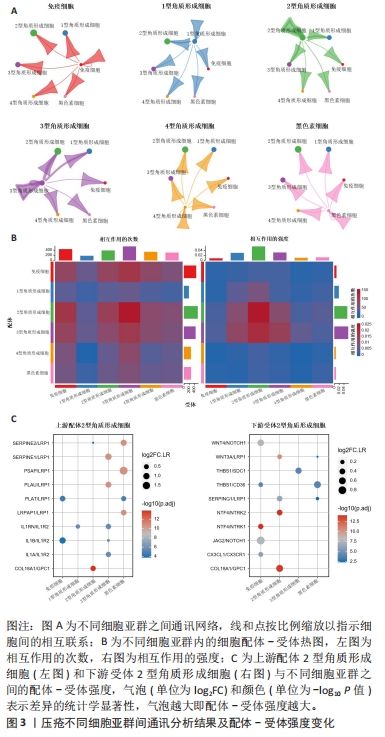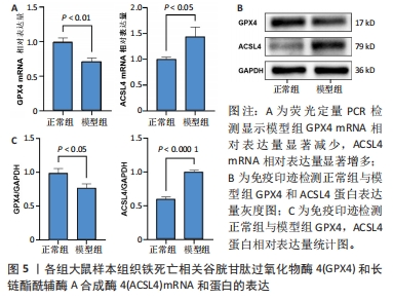Chinese Journal of Tissue Engineering Research ›› 2024, Vol. 28 ›› Issue (35): 5656-5661.doi: 10.12307/2024.600
Previous Articles Next Articles
Regulatory mechanism of ferroptosis on pressure ulcers: bioinformatics analysis and experimental validation
Tang Lulu1, Pan Xiaojia1, Lai Yingtao2, Wang Li3
- 1The First College of Clinical Medicine, Guangzhou University of Chinese Medicine, Guangzhou 510405, Guangdong Province, China; 2The First Affiliated Hospital, Guangzhou University of Chinese Medicine, Guangzhou 510405, Guangdong Province, China; 3School of Basic Medical Science, Guangzhou University of Chinese Medicine, Guangzhou 510006, Guangdong Province, China
-
Received:2023-11-17Accepted:2023-12-21Online:2024-12-18Published:2024-03-15 -
Contact:Lai Yingtao, Chief nurse practitioner, Master’s supervisor, The First Affiliated Hospital of Guangzhou University of Chinese Medicine, Guangzhou 510405, Guangdong Province, China Wang Li, PhD candidate, School of Basic Medical Science, Guangzhou University of Chinese Medicine, Guangzhou 510006, Guangdong Province, China -
About author:Tang Lulu, Master candidate, First Clinical Medical College, Guangzhou University of Chinese Medicine, Guangzhou 510405, Guangdong Province, China -
Supported by:Scientific Research Project of Guangdong Provincial Bureau of Traditional Chinese Medicine, No. 20231128 (to LYT)
CLC Number:
Cite this article
Tang Lulu, Pan Xiaojia, Lai Yingtao, Wang Li. Regulatory mechanism of ferroptosis on pressure ulcers: bioinformatics analysis and experimental validation[J]. Chinese Journal of Tissue Engineering Research, 2024, 28(35): 5656-5661.
share this article
Add to citation manager EndNote|Reference Manager|ProCite|BibTeX|RefWorks
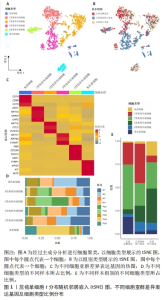
2.2 单细胞聚类结果和比例分布 对数据集进行归一化、降维、批次校正、聚类后,获得了1 170个细胞(每个细胞平均5 223个基因)的压疮单细胞转录组图谱。所有细胞被划分为6种细胞类型,包括黑色素细胞(melanocytes,TYRP1,CDH19,MLANA)、免疫细胞 (immune cells,CD74,PTPRC,CD45)、1型角质形成细胞 (KC_1,KRT1,KRT10,DMKN,CHP2)、2型角质形成细胞 (KC_2,KRT15,IFITM1,CCL2,POSTN,CXCL14)、3型角质形成细胞 (KC_3,KRT17,KRT6A,KRT6B,S100A7,S100A8)、4型角质形成细胞 (KC_4,PBK,CDCA8,COL17A1,ASS1),注释为6个细胞亚群,见图1A。每个细胞亚群都包含正常完整表皮、正常急性伤口表皮和压疮伤口表皮3种样本类型的细胞,见图1B。热图展示每个细胞亚群中差异表达基因,验证了细胞注释的准确性,见图1C。所有样本含有至少4种细胞类型,包括免疫细胞、2型角质形成细胞、3型角质形成细胞、4型角质形成细胞,同时不同样本在细胞类型占比上的差异较大,见图1D。与正常完整表皮组和正常急性伤口表皮组相比,压疮伤口表皮组2型角质形成细胞和3型角质形成细胞所占比例较高,见图1E。"
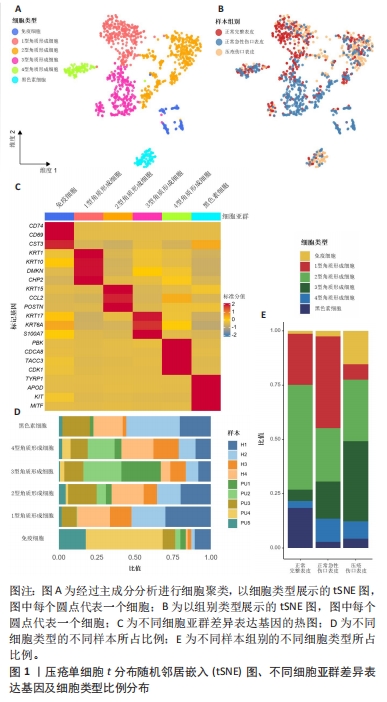
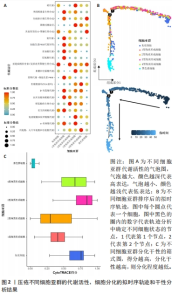
2.3 细胞亚群的代谢变化和拟时序演变 不同细胞亚群之间具有明显的代谢异质性。免疫细胞在重链硫酸软骨素/皮肤素类聚糖生物合成显著表达;角质形成细胞主要富集于组氨酸代谢、β-丙氨酸代谢、精氨酸生物合成、丙氨酸、天冬氨酸和谷氨酸代谢等相关功能;黑色素细胞富集于初级胆酸生物合成、其他类型的O-聚糖生物合成等功能,见图2A。 此外,细胞轨迹可以分为2个分化阶段,免疫细胞、3型角质形成细胞和4型角质形成细胞主要处在分化的起始位置;1型角质形成细胞和2型角质形成细胞处在分化的中间;黑色素细胞位于拟时序轨迹的末端,见图2B。“CytoTRACE”得分越高表明细胞的分化干性越高,则分化程度越低,结果显示免疫细胞、3型角质形成细胞和4型角质形成细胞具有较高的的干性,验证了拟时序轨迹的分轨过程,见图2C。"
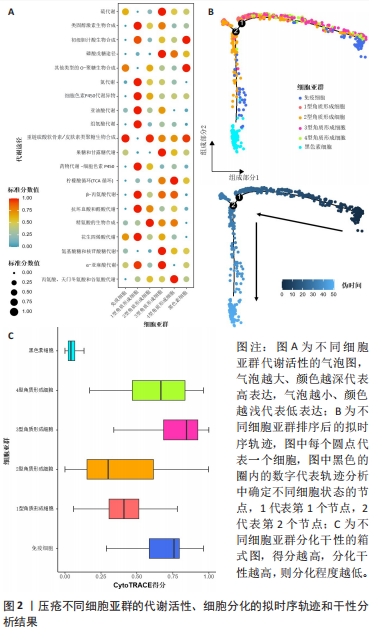
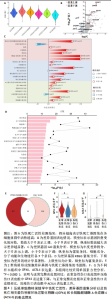
2.5 铁死亡对压疮的影响 通过“Aucell”计算铁死亡基因集在每个细胞的基因中表达情况。结果显示,1型角质形成细胞和2型角质形成细胞的铁死亡得分最高,见图4A。在模型组织细胞中,检测显著上调或下调的2型角质形成细胞差异基因,见图4B。对差异基因进行GO和KEGG富集分析,得到27个GO富集条目和20个KEGG富集条目,见图4C,D。将2型角质形成细胞的差异基因与铁死亡基因集取交集,得到24个铁死亡相关差异基因,见图4E。随后,基于铁死亡差异基因,评估铁死亡抑制蛋白GPX4和铁死亡促进蛋白ACSL4在不同组织中的表达情况。结果显示,与正常完整表皮组相比,正常急性伤口表皮组和压疮伤口表皮组中GPX4表达量下降(P < 0.000 1),见图4F;与正常完整表皮组和正常急性伤口表皮组相比,压疮伤口表皮组中ACSL4表达量上升 (P < 0.000 1),见图4G。"
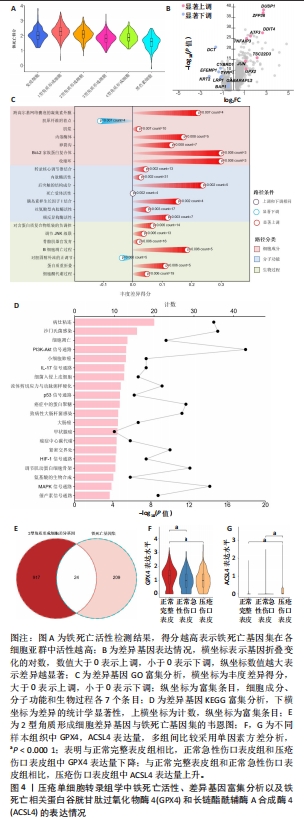
| [1] MERVIS JS, PHILLIPS TJ. Pressure ulcers: pathophysiology, epidemiology, risk factors, and presentation. J Am Acad Dermatol. 2019;81(4):881-890. [2] MAKITA K, OTSUKA N, TOMARU U, et al. NKG2D ligand expression induced by oxidative stress mitigates cutaneous ischemia-reperfusion injury. J Histochem Cytochem. 2023;71(2):61-72. [3] KIM E, HAM S, JUNG BK, et al. Effect of baicalin on wound healing in a mouse model of pressure ulcers. Int J Mol Sci. 2022;24(1):329. [4] BINIAZAN F, RAJAEI F, DARABI S, et al. Effects of placenta-derived human amniotic epithelial cells on the wound healing process and TGF-β induced scar formation in murine ischemic-reperfusion injury model. Stem Cell Rev Rep. 2022;18(6):2045-2058. [5] INOUE Y, UCHIYAMA A, AMALIA SN, et al. Keratinocyte-specific SOX2 overexpression suppressed pressure ulcer formation after cutaneous ischemia-reperfusion injury via enhancement of amphiregulin production. J Invest Dermatol. 2024; 144(1):142-151.e5. [6] WANG YX, LI B, LIU GT, et al. Corilagin attenuates intestinal ischemia/reperfusion injury in mice by inhibiting ferritinophagy-mediated ferroptosis through disrupting NCOA4-ferritin interaction. Life Sci. 2023;334:122176. [7] LI J, CAO F, YIN HL, et al. Ferroptosis: past, present and future. Cell Death Dis. 2020; 11(2):88. [8] WANG ZR, YAO MR, JIANG LY, et al. Dexmedetomidine attenuates myocardial ischemia/reperfusion-induced ferroptosis via AMPK/GSK-3β/Nrf2 axis. Biomed Pharmacother. 2022;154:113572. [9] CHEN X, KANG R, KROEMER G, et al. Broadening horizons: the role of ferroptosis in cancer. Nat Rev Clin Oncol. 2021;18(5):280-296. [10] FENG JW, WANG JL, WANG YQ, et al. Oxidative stress and lipid peroxidation: prospective associations between ferroptosis and delayed wound healing in diabetic ulcers. Front Cell Dev Biol. 2022;10:898657. [11] YAN HF, TUO QZ, YIN QZ, et al. The pathological role of ferroptosis in ischemia/reperfusion-related injury. Zool Res. 2020;41(3):220-230. [12] 原凌燕,贺云,汤云燕,等.表没食子儿茶素没食子酸酯对早期压疮大鼠模型缺血再灌注损伤的保护作用及NLRP3炎症小体相关机制研究[J].中药药理与临床,2019,35(1):43-47. [13] 韩凤玉,闫凤华,张俊飞,等.枸杞多糖促进压疮大鼠皮肤创面愈合的作用机制研究[J].宁夏医学杂志,2023,45(1):5-7. [14] 王智槟,邹晓玲,邹译娴,等.基于Nrf2/HO-1/GPX4信号轴探讨参芪地黄汤抑制高糖诱导人肾小管上皮细胞铁死亡的作用机制[J].中国中药杂志,2023, 48(19):5337-5344. [15] 范志能,周厚清.黄柏酮通过调控铁死亡途径对心肌缺血/再灌注大鼠心肌损伤的保护作用研究[J].中国医院药学杂志,2023,43(17):1932-1938. [16] 李丽琴,张鼎,袁莉,等.温阳复元方联合miR-137模拟剂调控线粒体铁死亡对脑缺血再灌注损伤大鼠的作用机制[J].陕西中医,2023,44(10):1354-1359. [17] ZHANG M, YANG H, WAN LF, et al. Single-cell transcriptomic architecture and intercellular crosstalk of human intrahepatic cholangiocarcinoma. J Hepatol. 2020; 73(5):1118-1130. [18] LI DQ, CHENG SL, PEI Y, et al. Single-cell analysis reveals major histocompatibility complex II‒expressing keratinocytes in pressure ulcers with worse healing outcomes. J Invest Dermatol. 2022;142(3 Pt A):705-716. [19] JIN SQ, GUERRERO-JUAREZ CF, ZHANG LH, et al. Inference and analysis of cell-cell communication using CellChat. Nat Commun. 2021;12(1):1088. [20] Wu TZ, Hu EQ, Xu SB, et al. ClusterProfiler 4.0: a universal enrichment tool for interpreting omics data. Innovation (Camb). 2021;2(3):100141. [21] KOTTNER J, CUDDIGAN J, CARVILLE K, et al. Prevention and treatment of pressure ulcers/injuries: the protocol for the second update of the international clinical practice guideline 2019. J Tissue Viability. 2019;28(2):51-58. [22] QUIŃOZ GALLARDO MD, BARRIENTOS-TRIGO S, PORCEL- GÁLVEZ AM. Effectiveness of the best practice spotlight organizations program to reduce the prevalence of pressure injuries in acute care settings for hospitalized patients in Spain: a quasi-experimental study. Worldviews Evid Based Nurs. 2023;20(4):306-314. [23] QIANG L, YANG SW, CUI YH, et al. Keratinocyte autophagy enables the activation of keratinocytes and fibroblastsand facilitates wound healing. Autophagy. 2021; 17(9):2128-2143. [24] PIIPPONNE M, LI D, LANDÉN NX. The immune functions of keratinocytes in skin wound healing. Int J Mol Sci. 2020;21(22):8790. [25] TAKEO M, LEE W, ITO M. Wound healing and skin regeneration. Cold Spring Harb Perspect Med. 2015;5(1):a023267. [26] SHEDOEVA A, LEAVESLEY D, UPTON Z, et al. Wound healing and the use of medicinal plants. Evid Based Complement Alternat Med. 2019;2019:2684108. [27] ARRIBAS-LÓPEZ E, ZAND N, OJO O, et al. The effect of amino acids on wound healing: a systematic review and meta-analysis on arginine and glutamine. Nutrients. 2021;13(8):2498. [28] CHU AS, DELMORE B. Arginine: what you need to know for pressure injury healing. Adv Skin Wound Care. 2021;34(12):630-636. [29] SPEECKAERT R, DUGARDIN J, LAMBERT J, et al. Critical appraisal of the oxidative stress pathway in vitiligo: a systematic review and meta-analysis. J Eur Acad Dermatol Venereol. 2018;32(7):1089-1098. [30] 张喆,王琪,陈佳希,等.氧化应激下角质形成细胞中YTHDC1升高促进IL-1β表达[J].现代生物医学进展,2022,22(10):1811-1816. [31] GALLUZZI L, VITALE I, AARONSON SA, et al. Molecular mechanisms of cell death: recommendations of the nomenclature committee on cell death 2018. Cell Death Differ. 2018;25(3):486-541. [32] 王莹,代彦丽,朴金龙,等.炎症因子、生长因子以及凋亡因子在压疮慢性难愈合性创面中的表达及作用[J].中国应用生理学杂志,2017,33(2):181-184,188. [33] HE SX, LI R, PENG YM, et al. ACSL4 contributes to ferroptosis-mediated rhabdomyolysis in exertional heat stroke. J Cachexia Sarcopenia Muscle. 2022;13(3):1717-1730. [34] BERSUKER K, HENDRICKS JM, LI Z, et al. The CoQ oxidoreductase FSP1 acts parallel to GPX4 to inhibit ferroptosis. Nature. 2019;575(7784):688-692. [35] FORCINA GC, DIXON SJ. GPX4 at the crossroads of lipid homeostasis and ferroptosis. Proteomics. 2019;19(18):e1800311. [36] YUAN H, LI XM, ZHANG XY, et al. Identification of ACSL4 as a biomarker and contributor of ferroptosis. Biochem Biophys Res Commun. 2016;478(3):1338-1343. [37] DOLL S, PRONETH B, TYURINA YY, et al. ACSL4 dictates ferroptosis sensitivity by shaping cellular lipid composition. Nat Chem Biol. 2017;13(1):91-98. [38] QIU CW, CHEN B, ZHU HF, et al. Gastrodin alleviates cisplatin nephrotoxicity by inhibiting ferroptosis via the SIRT1/FOXO3A/GPX4 signaling pathway. J Ethnopharmacol. 2024;319(Pt 3):117282. [39] TANG LJ, LUO XJ, TU H, et al. Ferroptosis occurs in phase of reperfusion but not ischemia in rat heart following ischemia or ischemia/reperfusion. Naunyn Schmiedebergs Arch Pharmacol. 2021;394(2):401-410. |
| [1] | Yang Yifeng, Ye Nan, Wang Lin, Guo Shuaicheng, Huang Jian. Signaling pathway of dexmedetomidine against ischemia-reperfusion injury [J]. Chinese Journal of Tissue Engineering Research, 2024, 28(9): 1464-1469. |
| [2] | Shen Jiangyong, He Xi, Tang Yuting, Wang Jianjun, Liu Jinyi, Chen Yuanyuan, Wang Xinyi, Liu Tong, Sun Haoyuan. RAS-selective lethal small molecule 3 inhibits the fibrosis of pathological scar fibroblasts [J]. Chinese Journal of Tissue Engineering Research, 2024, 28(8): 1168-1173. |
| [3] | Yue Yun, Wang Peipei, Yuan Zhaohe, He Shengcun, Jia Xusheng, Liu Qian, Li Zhantao, Fu Huiling, Song Fei, Jia Menghui. Effects of croton cream on JNK/p38 MAPK signaling pathway and neuronal apoptosis in cerebral ischemia-reperfusion injury rats [J]. Chinese Journal of Tissue Engineering Research, 2024, 28(8): 1186-1192. |
| [4] | Lou Guo, Zhang Yan, Fu Changxi. Role of endothelial nitric oxide synthase in exercise preconditioning-induced improvement of myocardial ischemia-reperfusion injury [J]. Chinese Journal of Tissue Engineering Research, 2024, 28(8): 1283-1288. |
| [5] | Pan Xiaolong, Fan Feiyan, Ying Chunmiao, Liu Feixiang, Zhang Yunke. Effect and mechanism of traditional Chinese medicine on inhibiting the aging of mesenchymal stem cells [J]. Chinese Journal of Tissue Engineering Research, 2024, 28(7): 1091-1098. |
| [6] | Wang Mingming, Zhang Zhong, Sun Jianhua, Zhao Gang, Song Hua, Yan Huadong, Lyu Bin. Finite element analysis of three different minimally invasive fixation methods for distal tibial fractures with soft tissue injury [J]. Chinese Journal of Tissue Engineering Research, 2024, 28(6): 879-885. |
| [7] | Yang Yifeng, Huang Jian, Ye Nan, Wang Lin. Ischemia-reperfusion injury in total knee arthroplasty [J]. Chinese Journal of Tissue Engineering Research, 2024, 28(6): 955-960. |
| [8] | Bu Xianzhong, Bu Baoxian, Xu Wei, Zhang Chi, Zhang Yisheng, Zhong Yuanming, Li Zhifei, Tang Fubo, Mai Wei, Zhou Jinyan. Analysis of serum differential proteomics in patients with acute cervical spondylotic radiculopathy [J]. Chinese Journal of Tissue Engineering Research, 2024, 28(4): 535-541. |
| [9] | Zhang Yaru, Chen Yanjun, Zhang Xiaodong, Chen Shenghua, Huang Wenhua. Effect of ferroptosis mediated by glutathione peroxidase 4 in the occurrence and progression of synovitis in knee osteoarthritis [J]. Chinese Journal of Tissue Engineering Research, 2024, 28(4): 550-555. |
| [10] | Linghu Xitao, Gui Jiaqi, Liang Zhuozhi, Wa Qingde, Huang Shuai. Bioinformatics analysis of m6A-associated genes in steroid-induced osteonecrosis of the femoral head [J]. Chinese Journal of Tissue Engineering Research, 2024, 28(36): 5811-5816. |
| [11] | Xie Yanli, Wei Siang, Zhang Guodong. Effects of treadmill exercise on metabolism and chronic neuroinflammation in type 1 diabetes mice of different sexes [J]. Chinese Journal of Tissue Engineering Research, 2024, 28(35): 5577-5583. |
| [12] | Lan Yao, Chen Liuyang, Song Wenhui. Key biomarkers for the diagnosis of intervertebral disc degeneration associated with oxidative stress: identification based on bioinformatics and machine learning [J]. Chinese Journal of Tissue Engineering Research, 2024, 28(35): 5591-5597. |
| [13] | Dong Gengxin, Li Yiting, Hong Yinglu, Bao Dapeng. Effect of hydrogen-rich gas on proprioception and muscle endurance after high-intensity exercise [J]. Chinese Journal of Tissue Engineering Research, 2024, 28(34): 5413-5418. |
| [14] | Wang Yueguang, Mu Xiaohong, Jiang Shengyuan, Deng Bowen, Kang Ximei, Su Jianguang. Correlation between early serum markers and AISA grading in patients with acute spinal cord injury [J]. Chinese Journal of Tissue Engineering Research, 2024, 28(34): 5494-5499. |
| [15] | Li Wei, Chai Jinlian, Jia Haifeng, Li Hanzheng, Sun Tiefeng, Liang Xuezhen. Causal association of micronutrients with osteonecrosis: evidence from a bidirectional Mendelian randomization trial [J]. Chinese Journal of Tissue Engineering Research, 2024, 28(33): 5308-5314. |
| Viewed | ||||||
|
Full text |
|
|||||
|
Abstract |
|
|||||
